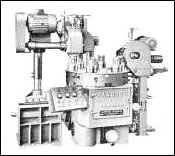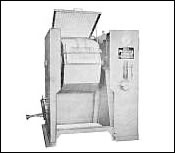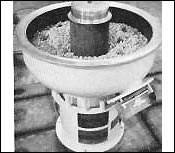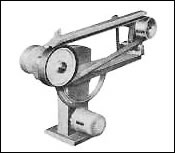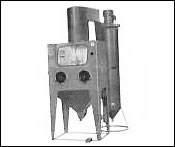(4)Metal cleaning process
The metal cleaning processes vary depending on the material or size of an item you are going to clean, the purpose of cleaning, or the degree of contamination. In general, the metal cleaning consists of the following processes:
(1)Mechanical pretreatment
Acid picking used to be a common method of removing serious contamination, such as red rust, mill scales, or scales from heat treatment in the air. Today, the dirt removal methods without using water, such as shot blasting, are becoming more common from the viewpoint of environmental conservation.
For products requiring hairline, satin finish, or matting after surface treatments, prepare the surface base in advance. Create hairlines using emery wheels or wheel brushes in various sizes and prepare a satin finish using sand, grit, or glass beads.
These treatments do not work well if any oily spot exists on the product. Be sure to remove all the grease from the products prior to performing these treatments.
(2)Alkaline degreasing
To remove oil-based stains, prepare a solution by dissolving surfactants or chelating agents into an alkaline solution. Soak the product and heat the solution to 40 to 60℃. Stir the liquid or swing the product in the solution to remove dirt.
(3)Acid pickling
To remove oxide films generated by metal processing or to eliminate relatively mild contamination of metallic origin, perform acid pickling using 10 to 20% hydrochloric acid or sulfuric acid. Add a dissolution inhibitor to prevent hydrogen embrittlement or excessive dissolution of the basis metal.
(4)Electrolytic cleaning
Both acid and alkaline solutions are available. In practice, alkaline solutions are more common. Although the bath composition is not so much different from alkaline degreasing, this method can perform more precise cleaning by lifting up dirt from the substrate using hydrogen and oxygen generated from electrolysis of water along with the cleaning process by oxidation-reduction.
Oxidation or reduction occurs on the metal surface depending on whether the product is positively charged or negatively charged. Select an appropriate reaction based on the type of basis metal and the degree of contamination. It is also possible to use both reactions by adopting periodic reverse current electrolysis or pulse electrolysis method that can change the polarity in a cyclic manner.
(5)Activation bath
Perform neutralization if the final process of pretreatment and the next surface treatment alkalify or acidify the products. For example, neutralize and activate the surface using acid picking after electrolytic cleaning that alkalified the product.
